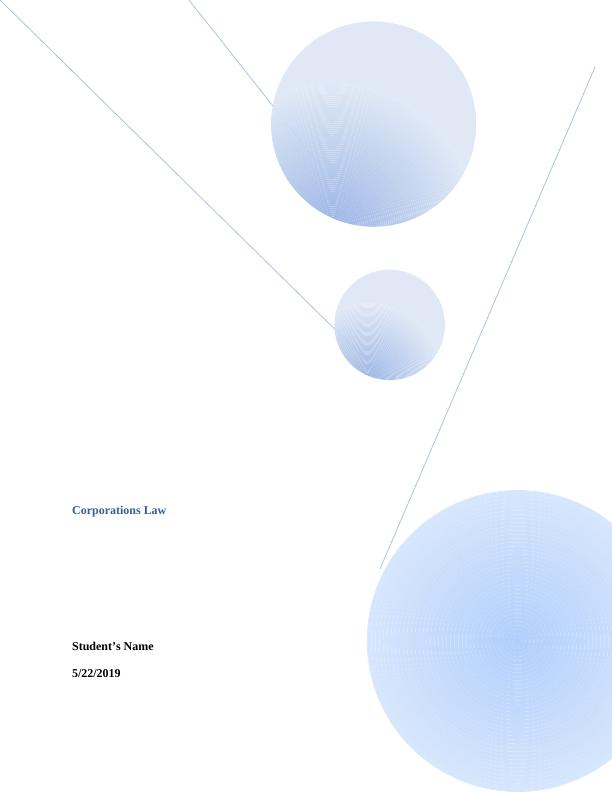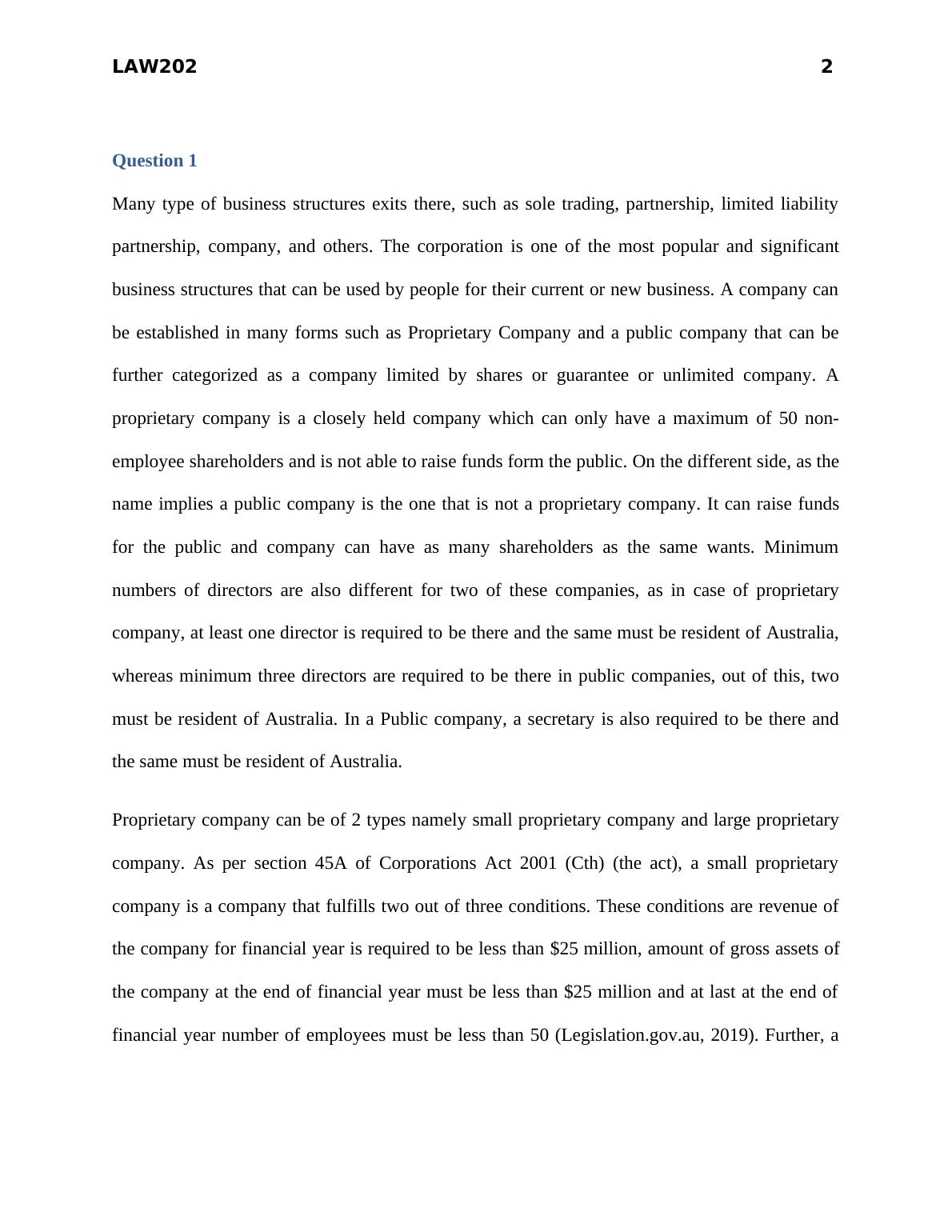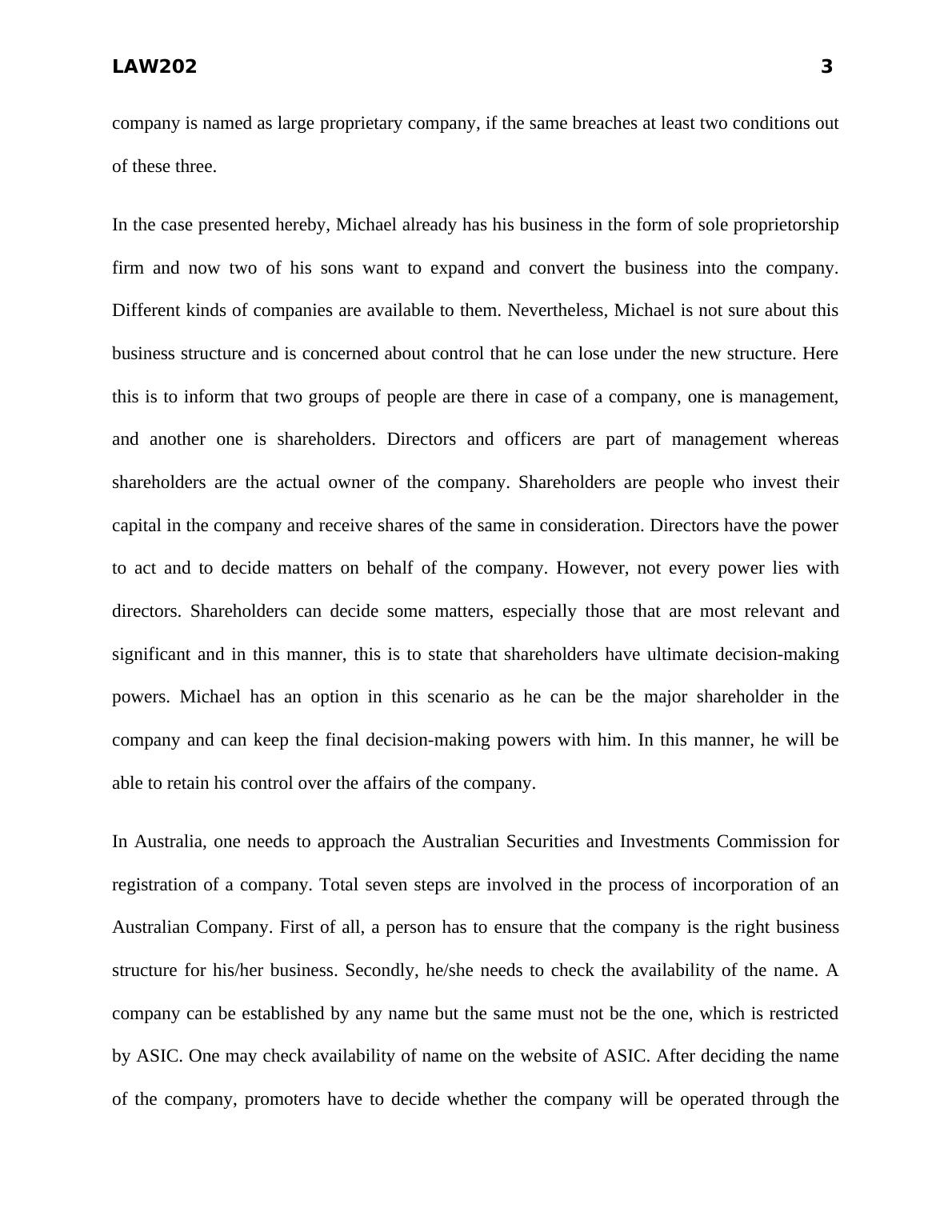Corporations Law: Advantages and Disadvantages of Company Structure
Added on 2022-11-14
11 Pages2647 Words436 Views
Corporations Law
Student’s Name
5/22/2019
Student’s Name
5/22/2019

LAW202 1
Contents
Question 1........................................................................................................................................2
Question 2........................................................................................................................................6
Issue.............................................................................................................................................6
Rules.............................................................................................................................................6
Application...................................................................................................................................8
Conclusion...................................................................................................................................9
References......................................................................................................................................10
Contents
Question 1........................................................................................................................................2
Question 2........................................................................................................................................6
Issue.............................................................................................................................................6
Rules.............................................................................................................................................6
Application...................................................................................................................................8
Conclusion...................................................................................................................................9
References......................................................................................................................................10

LAW202 2
Question 1
Many type of business structures exits there, such as sole trading, partnership, limited liability
partnership, company, and others. The corporation is one of the most popular and significant
business structures that can be used by people for their current or new business. A company can
be established in many forms such as Proprietary Company and a public company that can be
further categorized as a company limited by shares or guarantee or unlimited company. A
proprietary company is a closely held company which can only have a maximum of 50 non-
employee shareholders and is not able to raise funds form the public. On the different side, as the
name implies a public company is the one that is not a proprietary company. It can raise funds
for the public and company can have as many shareholders as the same wants. Minimum
numbers of directors are also different for two of these companies, as in case of proprietary
company, at least one director is required to be there and the same must be resident of Australia,
whereas minimum three directors are required to be there in public companies, out of this, two
must be resident of Australia. In a Public company, a secretary is also required to be there and
the same must be resident of Australia.
Proprietary company can be of 2 types namely small proprietary company and large proprietary
company. As per section 45A of Corporations Act 2001 (Cth) (the act), a small proprietary
company is a company that fulfills two out of three conditions. These conditions are revenue of
the company for financial year is required to be less than $25 million, amount of gross assets of
the company at the end of financial year must be less than $25 million and at last at the end of
financial year number of employees must be less than 50 (Legislation.gov.au, 2019). Further, a
Question 1
Many type of business structures exits there, such as sole trading, partnership, limited liability
partnership, company, and others. The corporation is one of the most popular and significant
business structures that can be used by people for their current or new business. A company can
be established in many forms such as Proprietary Company and a public company that can be
further categorized as a company limited by shares or guarantee or unlimited company. A
proprietary company is a closely held company which can only have a maximum of 50 non-
employee shareholders and is not able to raise funds form the public. On the different side, as the
name implies a public company is the one that is not a proprietary company. It can raise funds
for the public and company can have as many shareholders as the same wants. Minimum
numbers of directors are also different for two of these companies, as in case of proprietary
company, at least one director is required to be there and the same must be resident of Australia,
whereas minimum three directors are required to be there in public companies, out of this, two
must be resident of Australia. In a Public company, a secretary is also required to be there and
the same must be resident of Australia.
Proprietary company can be of 2 types namely small proprietary company and large proprietary
company. As per section 45A of Corporations Act 2001 (Cth) (the act), a small proprietary
company is a company that fulfills two out of three conditions. These conditions are revenue of
the company for financial year is required to be less than $25 million, amount of gross assets of
the company at the end of financial year must be less than $25 million and at last at the end of
financial year number of employees must be less than 50 (Legislation.gov.au, 2019). Further, a

LAW202 3
company is named as large proprietary company, if the same breaches at least two conditions out
of these three.
In the case presented hereby, Michael already has his business in the form of sole proprietorship
firm and now two of his sons want to expand and convert the business into the company.
Different kinds of companies are available to them. Nevertheless, Michael is not sure about this
business structure and is concerned about control that he can lose under the new structure. Here
this is to inform that two groups of people are there in case of a company, one is management,
and another one is shareholders. Directors and officers are part of management whereas
shareholders are the actual owner of the company. Shareholders are people who invest their
capital in the company and receive shares of the same in consideration. Directors have the power
to act and to decide matters on behalf of the company. However, not every power lies with
directors. Shareholders can decide some matters, especially those that are most relevant and
significant and in this manner, this is to state that shareholders have ultimate decision-making
powers. Michael has an option in this scenario as he can be the major shareholder in the
company and can keep the final decision-making powers with him. In this manner, he will be
able to retain his control over the affairs of the company.
In Australia, one needs to approach the Australian Securities and Investments Commission for
registration of a company. Total seven steps are involved in the process of incorporation of an
Australian Company. First of all, a person has to ensure that the company is the right business
structure for his/her business. Secondly, he/she needs to check the availability of the name. A
company can be established by any name but the same must not be the one, which is restricted
by ASIC. One may check availability of name on the website of ASIC. After deciding the name
of the company, promoters have to decide whether the company will be operated through the
company is named as large proprietary company, if the same breaches at least two conditions out
of these three.
In the case presented hereby, Michael already has his business in the form of sole proprietorship
firm and now two of his sons want to expand and convert the business into the company.
Different kinds of companies are available to them. Nevertheless, Michael is not sure about this
business structure and is concerned about control that he can lose under the new structure. Here
this is to inform that two groups of people are there in case of a company, one is management,
and another one is shareholders. Directors and officers are part of management whereas
shareholders are the actual owner of the company. Shareholders are people who invest their
capital in the company and receive shares of the same in consideration. Directors have the power
to act and to decide matters on behalf of the company. However, not every power lies with
directors. Shareholders can decide some matters, especially those that are most relevant and
significant and in this manner, this is to state that shareholders have ultimate decision-making
powers. Michael has an option in this scenario as he can be the major shareholder in the
company and can keep the final decision-making powers with him. In this manner, he will be
able to retain his control over the affairs of the company.
In Australia, one needs to approach the Australian Securities and Investments Commission for
registration of a company. Total seven steps are involved in the process of incorporation of an
Australian Company. First of all, a person has to ensure that the company is the right business
structure for his/her business. Secondly, he/she needs to check the availability of the name. A
company can be established by any name but the same must not be the one, which is restricted
by ASIC. One may check availability of name on the website of ASIC. After deciding the name
of the company, promoters have to decide whether the company will be operated through the

End of preview
Want to access all the pages? Upload your documents or become a member.
Related Documents
Business and Corporate Lawlg...
|10
|2226
|58
Business and Corporation Lawlg...
|11
|2306
|256
BuS200 Business Management Assignmentlg...
|7
|1305
|227
Corporations and Business Structureslg...
|6
|2102
|41
Company Law: Business Structures, Liability, and Consumer Lawlg...
|11
|2342
|230
Costs of Business Structureslg...
|7
|2189
|85
